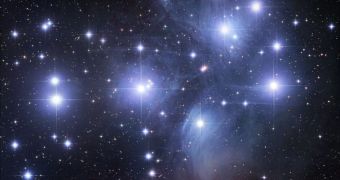Recent observations of the Pleiades open star cluster have revealed a star system that contains thousands of times more dust than around our Sun. The finding could imply that recent planetary collisions crippled the star's surroundings.
In a related finding, other stars in the cluster were determined to experience rapid planetary formation. Scientists identified several rocky extrasolar planets, which are either forming now, or have finished forming just recently.
Using the Hawaii-based Gemini Observatory and the infrared capabilities on the NASA Spitzer Space Telescope, the astronomers behind this research were able to image the star cluster – one of the closest such structures to Earth – in great detail.
Interestingly, the team reveals, it would appear that some of the rocky exoplanets now seen forming the result of catastrophic collisions between larger bodies, that have now been destroyed. The debris these behemoth planets left behind are now being recycled.
Located in the Taurus constellation, the Pleiades cluster contains mostly blue stars that formed within the last 100 million years or so. Its proximity to Earth makes it a prime target for both professional and amateur astronomical observations.
While using the two telescope to investigate the star HD 23514, two astronomers detected massive hot dust particle readings in the star's vicinity, Daily Galaxy reports. There are only a few things such a finding could imply.
“Hundreds of thousands of times as much dust as around our Sun. The dust must be the debris from a monster collision, a cosmic catastrophe,” explains Benjamin Zuckerman, a coauthor of the new study and a professor of physics and astronomy at the University of California in Los Angeles (UCLA).
These particles are the “building blocks of planets. These building blocks can eventually form asteroids, comets, and later on, clump together to form planetary embryos or planets,” adds NASA Spitzer Science Center (SSC) staff scientist Inseok Song.
The expert, who was also a coauthor of the new study, is a former astronomer with the Gemini Obseratory. “In the process of creating rocky, terrestrial planets, some objects collide and grow into planets, while others shatter into dust. We are seeing that dust,” he adds.
“Our observations indicate that terrestrial planets similar to those in our solar system are probably quite common,” Zuckerman observes.

 14 DAY TRIAL //
14 DAY TRIAL //